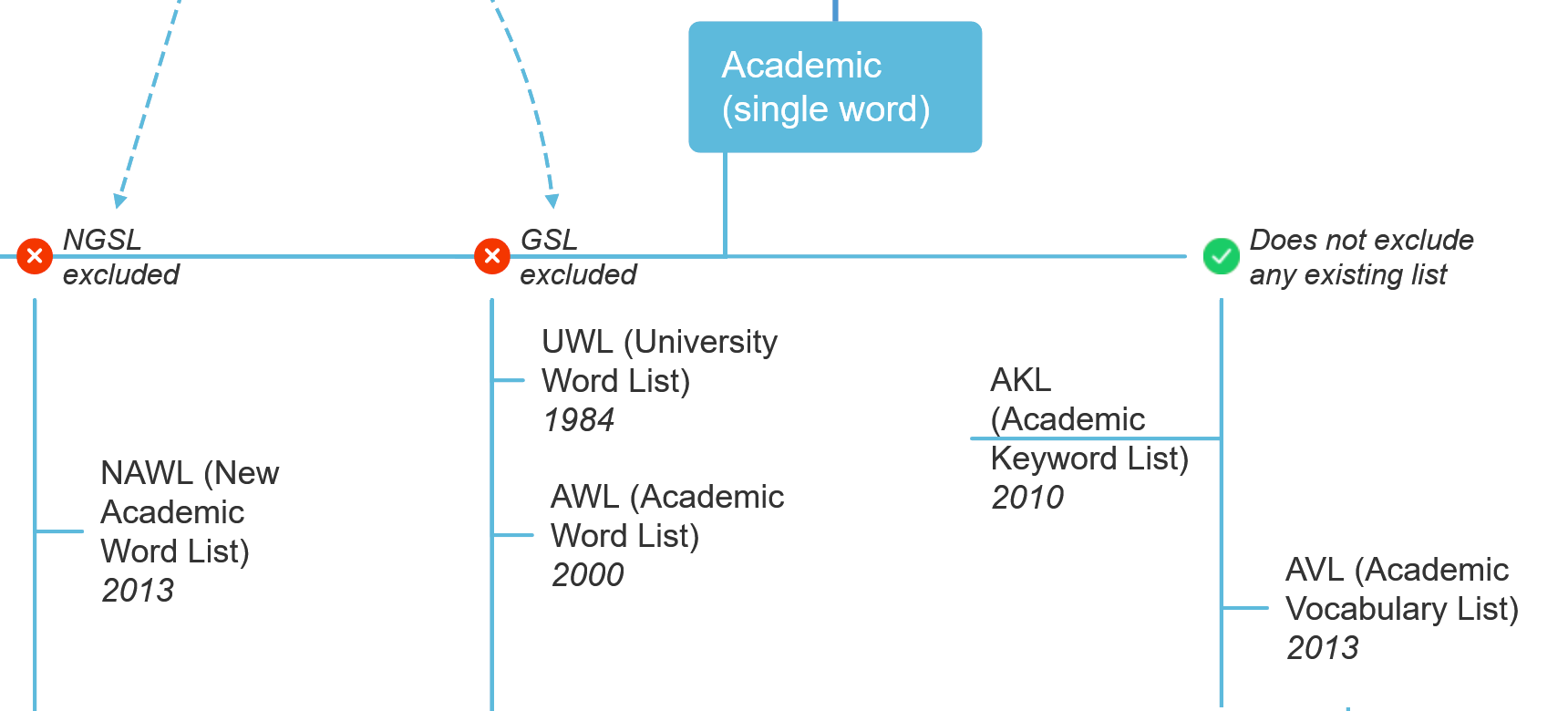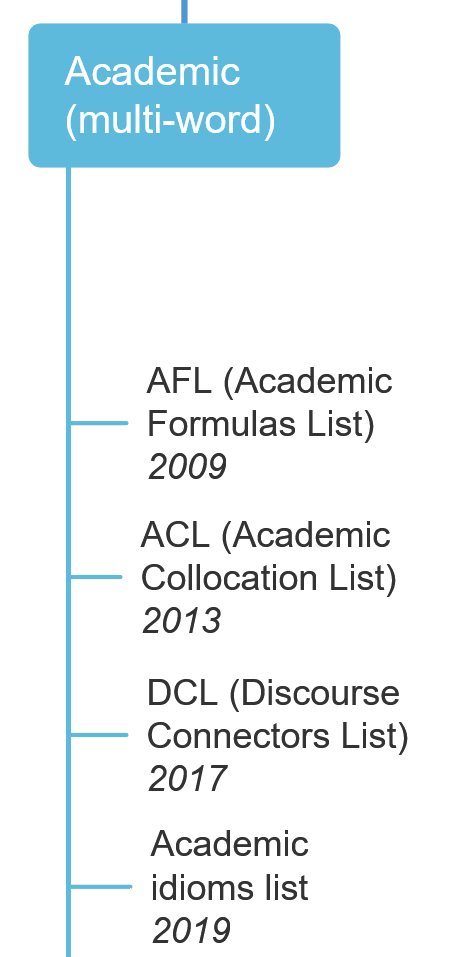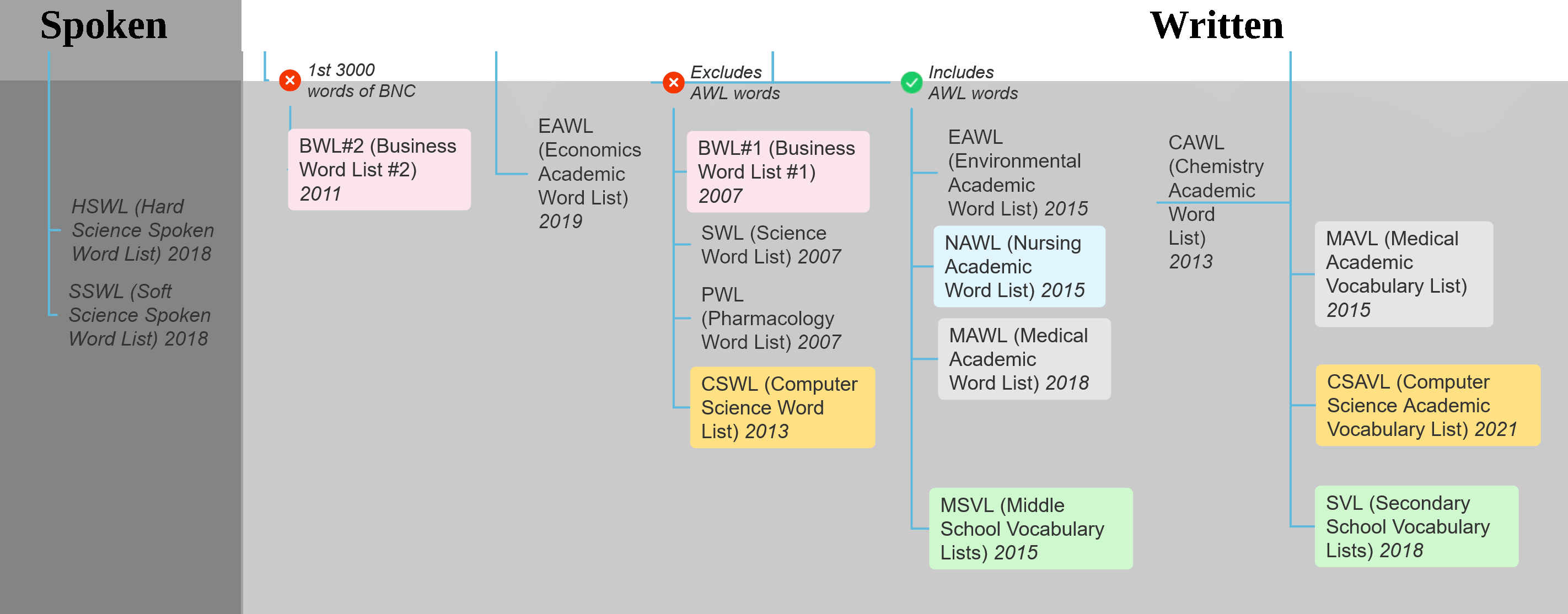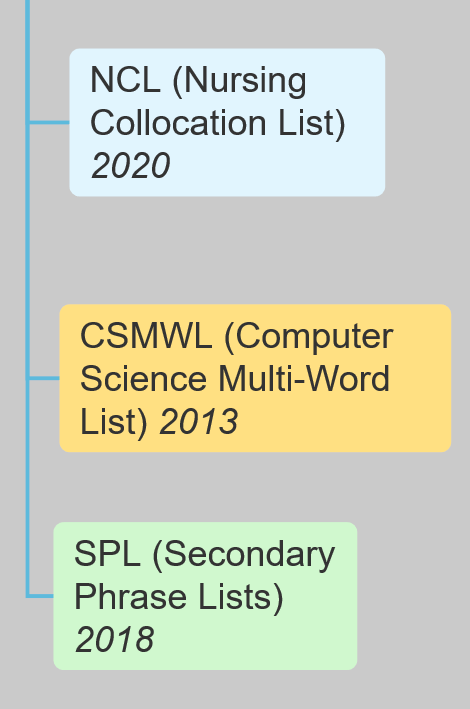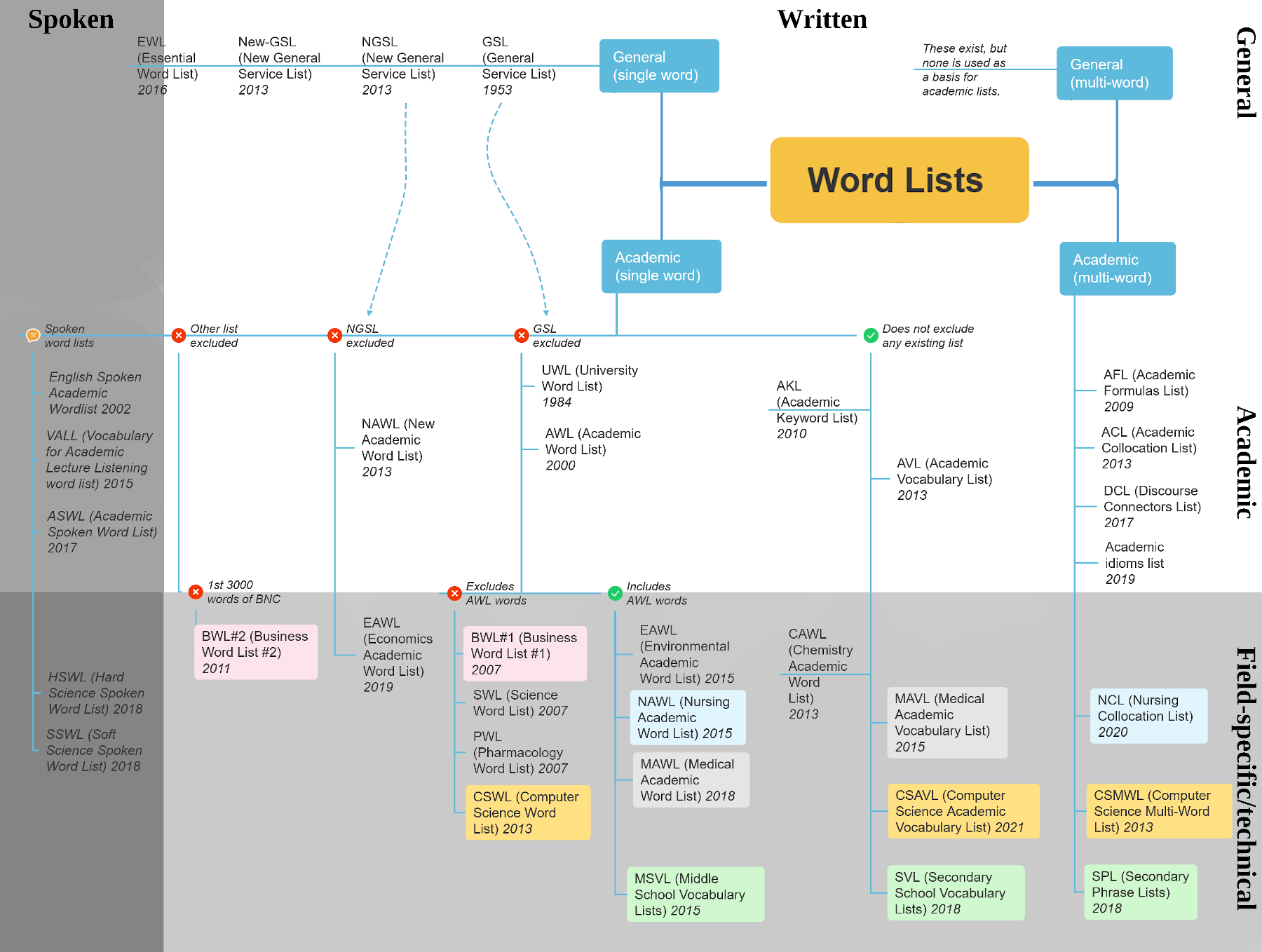Chinese Word Lists
- Grade {A}
- Grade {B}
- Grade {C}
- Grade {D}
Chinese grades {A} through {D} are adapted from HSK Cíyǔ Yòngfǎ Xiángjiě : HSK词语用法详解 : A Guide to the Usage of HSK Vocabulary, edited by Huáng Nánsōng 黄南松 and Sūn Déjīn 孙德津 (Beijing: Beijing Language and Cultural Press, 1998). The contents comprise 8,822 items classified in four grade levels, 甲级 {A} 1,033; 乙级 {B} 2,018; 丙级 {C} 2,202; and 丁级 {D} 3,569, in order of increasingly advanced language level. HSK stands for Hànyǔ Shuǐpíng Kǎoshì 汉语水平考试, Test of Chinese-language Ability. Grades {E} and {F} are explained below.
English Word Lists
- Grade {A} (中学程度)
- Grade {B} (大学 1-4 级)
- Grade {C} (大学 5-6 级)
- Grade {D} (大学 6 级以上)
English grades {A} through {D} are adapted from Dàxué Yīngyǔ Jiàoxué Dàgāng Cíhuìbiǎo : 大学英语教学大纲词汇表 : Word List for University English Teaching Programs, by Dàxué Yīngyǔ Jiàoxué Dàgāng Cíbiǎo Xiūdìng Gōngzuòzǔ 大学英语教学大纲词表修订工作组, Word List Revision Work Group for University English Teaching Programs. Shanghai: Shànghǎi Wàiyǔ Jiàoyù Chūbǎnshè, 2000. The contents comprise 6,500 terms classifed in four grade levels: {A} 1,800; {B} 2,400; {C} 1,300; and {D} 1,000. Grades {E} and {F} are explained below.
- Ogden Basic English {BE} Basic English: 850 terms first presented in Basic English: A General Introduction with Rules of Grammar, by Charles K. Ogden. London: Paul Treber, 1930.
Grades {E} and {F}, Chinese or English
Grade {E} indicates words that were chosen for inclusion in the portable book edition of the ABC English-Chinese/Chinese-English Dictionary, even though they were not in grades {A} through {D}. All words in grades {A} through {D}, both Chinese and English, are also included in that portable dictionary.
Grade {F} indicates some words that were considered for inclusion in the same book, but were excluded in order to keep it from becoming too large.
In addition to size, one of the factors that influenced the choice of which words to include in the portable dictionary was the principle of self-containment: any word used in a definition or example sentence must also have an entry in which it occurs as the headword. Thus, for example, if the word “acorn” had an entry in the English-Chinese side, with the definition “xiàngzǐ 橡子”, then the word “xiàngzǐ 橡子” must have an entry in the Chinese-English side. In unabridged editions of the dictionary, including this electronic edition published with Wenlin, of course there are many entries without any grade level indication.

Elementary School | Middle School | High School
VocabularySpellingCity provides free K-12 grade level spelling words and vocabulary lists. Fun, engaging word study instruction is a major part of the Common Core State Standards; VocabularySpellingCity’s grade level spelling lists support literature, content area vocabulary, and informational text in the CCSS, as well as providing content and ideas for writing lesson plans. Word lists can be paired with VocabularySpellingCity’s interactive learning games and printable worksheets to ensure student mastery in spelling and vocabulary.
VocabularySpellingCity’s word lists are created for teachers of all grade levels and subject areas. In addition, they help to enrich and remediate students. The K-12 word lists include popular literacy and reading programs, like Journeys; spelling based on Fountas and Pinnell’s latest research, Dolch and Fry sight words along with Fountas and Pinnell recommended high frequency words; vocabulary, like homonyms and homophones; and content specific vocabulary, like literature, math, science, and social studies. Teachers of grades K-3 spelling can access Dolch and Fry sight words, while teachers of grades 4 and on can find increasingly complex compound words to assign to students. All grade level lesson plans must include lessons on word work, vocabulary and word study; VocabularySpellingCity makes it easy to write effective spelling and vocabulary lesson plans along with units of study. From foundational elementary spelling programs to SAT/ACT test prep, VocabularySpellingCity has the tools you need to help your students succeed.

Grade Level Spelling Lists
The following grade level-appropriate spelling word lists and activities present a synopsis of grade level literacy standards and expected student abilities as well as grade level education standards. Since curricula and students’ abilities vary, teachers should check more than one grade level page to find suitable supplemental material. They are well-suited for lesson plans that differentiate instruction.
In addition, each page includes learning game and activity recommendations for the corresponding grade level list.
- Kindergarten
- 1st Grade
- 2nd Grade
- 3rd Grade
- 4th Grade
- 5th Grade
- 6th Grade
- 7th Grade
- 8th Grade
By Ashley Austrew
Whether you’re a teacher, a parent, or a high school student yourself, you’re probably aware that having a strong vocabulary is important for reading, writing, and speaking. In ninth through twelfth grades, students are not only tackling high-level coursework, but also preparing for their adult lives beyond school. The words they learn now will carry through into their later educational and career endeavors, and that makes it especially important to put in the effort to grow their vocabulary, literacy, and spelling skills.
To help get high schoolers back in the swing of things, we’ve put together 12 word lists with hundreds of essential vocabulary words for every stage of high school, along with flash cards, quizzes, and more. These words will not only help students in English class or while taking the SAT. They’ll also help students studying advanced science, history, art, political science, and more. Keep scrolling to learn them all!
When you’re preparing for the big tests in your life, turn to these word lists and quizzes build right for the SAT, ACT, and more.
Ninth-grade vocabulary words and tips
In ninth grade, students are making the transition into advanced learning that will prepare them for college, careers, and beyond. These students are exploring history, science, writing, and literature, and being able to spell and comprehend a great many multisyllabic words with multiple meanings is an important skill.
Ninth graders aren’t only studying words for their spelling or meaning, though. Rather, they’re studying vocabulary to gain a deeper understanding of language and the ability to analyze the impact of words in context. This is a requirement for much of the higher level learning and analysis done by students in high school. Reading remains important at this stage, as does studying new words to learn and use throughout their school work. Here are 75 vocabulary words ninth graders need to know.
- Ninth-Grade Vocab Word List 1
- absorption
- characteristic
- executive
- accomodation
- reference
- grateful
- ascend
- satisfactory
- interval
- civilization … full list
- Ninth-Grade Vocab Word List 2
- cocoon
- remembrance
- favorable
- precise
- interpretation
- accompaniment
- sensible
- ecstasy
- administration
- monotony … full list
- Ninth-Grade Vocab Word List 3
- adequate
- fiery
- adolescent
- suppress
- nuisance
- indispensable
- opposition
- lively
- commissioner
- hindrance … full list
Now take those ninth grade skills up a notch with this quiz!
Tenth-grade vocabulary words and tips
Students in tenth grade are building on many of the literacy skills they acquired in ninth grade. They’re able to not only decode complex words, but also to understand the figurative, connotative, and technical meanings within a text, analyze word choice, and determine the best words to use to convey their ideas.
Students at this stage are likely also preparing to take practice SAT and ACT tests within the coming year or so, making it all the more important for them to have a rich and robust vocabulary. Reviewing these word lists, practicing with flash cards, and taking advantage of our spelling and definition quizzes will help kids slowly and steadily make progress on this goal. Here are three word lists to help tenth graders feel ahead of the curve.
- Tenth-Grade Vocab Word List 1
- circumvent
- indigenous
- estrange
- anarchy
- dormant
- derogatory
- belligerent
- unilateral
- stringent
- connotation … full list
- Tenth-Grade Vocab Word List 2
- assiduous
- obscure
- vindicate
- expedite
- bolster
- coalition
- perfunctory
- nonchalant
- impetuous
- disseminate … full list
- Tenth-Grade Vocab Word List 3
- dissident
- subordinate
- admonish
- jurisdiction
- travesty
- precipitate
- alternative
- redeem
- bureaucratic
- validate … full list
Once you’ve reviewed these words, consider testing your expertise of tenth grade vocabulary with a quiz.
Eleventh-grade vocabulary words and tips
By eleventh grade, much of the focus for students is on college and career readiness. By the end of their eleventh-grade year, many students will have taken their ACT or SAT. They’re likely also looking at colleges they’d like to apply to during their senior year, and probably practicing those admissions essays as well. All of this makes a strong vocabulary an especially important thing to have.
Rather than cramming for a specific test or assignment, it will be helpful for eleventh graders to focus on study and enrichment all year long. They can use these three lists to get started by reviewing the words daily with digital flashcards and taking our accompanying word quizzes to see how much they’ve retained. With a little practice each day, these terms will be second nature to eleventh graders in no time.
- Eleventh-Grade Vocab Word List 1
- iconoclast
- aberration
- brevity
- affinity
- indoctrinate
- coalesce
- proximity
- debilitate
- contradiction
- effervescent … full list
- Eleventh-Grade Vocab Word List 2
- conciliatory
- scrutinize
- edifice
- biased
- heretic
- accolade
- dearth
- altercation
- usurp
- delineate … full list
- Eleventh-Grade Vocab Word List 3
- edifice
- aesthetic
- tirade
- caustic
- rigorous
- indict
- ponderance
- dilettante
- judicious
- ameliorate … full list
Think you can pass this eleventh grade vocab quiz? Only one way to find out!
Twelfth-grade vocabulary words and tips
In their final year of high school, students are able to interpret, use, and understand some of the most complex words in the English language. They’ve built up their vocabularies through their regular coursework and by studying for the SAT or ACT, if they’ve taken the tests or plan to. Students at this level are working with the real world in mind, and they need to be able to interpret language in a variety of settings.
So, what’s left to do? Plenty! It’s time to deepen their understanding of language and create a lifelong practice of learning and thinking about the way we use words. For twelfth graders, this may mean reading more complicated books and poetry, being adventurous in their writing, and seeking new opportunities for learning, which is a lifelong skill that will benefit them once they leave the four walls of the school building. They can start by getting familiar with these word lists. These words are ones they may need for test prep, college, their careers, and beyond. Start by reviewing the words, and then dig in to our spelling tests and quizzes to build a functional and seriously impressive vocabulary in no time.
- Twelfth-Grade Vocab Word List 1
- anachronism
- impute
- abdicate
- denouement
- camaraderie
- incompatible
- ephemeral
- prudent
- expository
- digression … full list
- Twelfth-Grade Vocab Word List 2
- evanescent
- abbreviate
- frugal
- hackneyed
- adulation
- longevity
- florid
- diligent
- wary
- rancorous … full list
- Twelfth-Grade Vocab Word List 3
- anecdote
- intrepid
- fortuitous
- ostentatious
- superfluous
- demagogue
- subtle
- arid
- transient
- collaborative … full list
Once you’ve reviewed these words, test yourself with this quiz built straight for twelfth grade vocabulary.
Ashley Austrew is a freelance journalist and writer from Omaha, Nebraska. Her work has been published at Cosmopolitan, Scary Mommy, Scholastic, and other outlets. For more by Ashley, read: “Teacher” vs. “Tutor”: Why Most Kids Need Both | Your Student Can Take Middle School By Storm With The Right Vocabulary | Make Your Writing The Star Of National Grammar Day With These Tips | How To Plan Out And Plan Ahead For Your Final Project
We suggest printing out these word lists, posting them on your fridge (or somewhere you and your child will see them easily and often), and making a point of using one or two at a time in everyday conversation with your child. Feeling creative? Make learning these new words into a game! The more fun you and your child have learning what these vocabulary words mean and practicing using them in conversation (even silly conversation), the better.
Academic vocabulary lists by grade level
1st grade word list
Here are the age-appropriate “big” words your first graders should learn this year.
2nd grade word list
These vocabulary words for second graders will help your child better understand what they’re reading in class.
3rd grade word list
Knowing words such as additional, example, and typical will boost your child reading and writing skills.
4th grade word list
Knowing words such as avoid, confirm, and obvious will enhance your child’s ability to read, learn, and communicate.
5th grade word list
These “hard” words are essential to your fifth grader’s reading comprehension, understanding of new concepts, and writing skills.
7th grade word list
These high-value vocabulary words for seventh graders are important for your child’s deeper understanding of meaning and context.
8th grade word list
These words are important for your child’s reading comprehension and overall understanding of new concepts across many subjects.
9th grade word list
Help your ninth grader learn these academic vocabulary words — it’ll help your teen with reading assignments, writing projects, and oral presentations.
10th grade word list
Help your teen learn these vocabulary words for tenth graders. It’ll help with assignments in every subject now — and with the SAT or ACT later.
11th grade word list
Knowing (and using!) these words will help your teen in school — and with college admissions tests and essays.
12th grade word list
Knowing (and using!) these vocabulary words will help your high school senior with schoolwork, college admissions tests, and college apps.
There are many word lists for general and academic English study. This page describes
the most important ones, first giving an
overview of the different types of word list, then presenting a
more detailed summary of individual lists.
The summary contains links to other pages on the site which have more detail of each list and (often) a complete copy of the list itself.
There is a companion page in this section which gives
information on why word lists are important (and tips on how to use them).
[Note: Links to other pages are in blue, links to other parts of this page are in red.]
Types of word list
Word lists can be divided into three types, namely
general word lists and
academic word lists, although as will be explained below, academic lists can be sub-divided into
general academic lists and
field-specific (i.e. subject-specific) academic lists.
An additional way to classify word lists is those which contain only single words (the majority of the lists are this type), and
multi-word lists. A final way to classify lists is written vs. spoken. Most of the lists that exist are
for written English, though many of the multi-word lists include both a spoken and written component.
General word lists (single words)
Interest in word lists began with studies of core or general vocabulary, that is, words having high frequency across a wide range of
texts. The first general word list to have important use in language study was the
General Service List (GSL), created by Michael West in 1953.
This list has been used to design EFL materials and courses, and, despite its age, it is probably still the most widely used list of general vocabulary.
Originally consisting of 2000 words (called headwords) and their corresponding word families, it was revised in 1995 by Bauman and Culligan,
with an increase in the number of headwords from 2000 to 2284.
One criticism of the GSL is its inclusion of too many low frequency words, some of which are a product of its age (e.g. shilling, headdress, cart, servant) while
excluding more recent vocabulary (e.g. computer, television, Internet). A second criticism is that it uses word families. The assumption behind the use of
word families is that once one word is known, other members of the family can be easily recognised; however, this may not always be the case. Examples of
distantly related word family pairs in the GSL are: please/unpleasantly, part/particle and value/invaluable. Additionally, some word
forms are used more frequently than others, and the inclusion of less frequent forms adds an unnecessarily burden to the learning load of students.
These criticisms have led to the creation of two updated versions of the list, both devised in 2013, both called the New General Service List.
Both lists use inflected forms and variant spellings (called lemmas), rather than extended word families.
The first, abbreviated to
NGSL, was developed by Browne, Culligan and Phillips. It is a list of 2801 words which give over 90% coverage.
It was generated from a corpus of 273 million words, 100 times larger than that used for the GSL.
The second list, abbreviated to
new-GSL, was devised by Brezina and Gablasova from a corpus of over 12 billion words.
It consists of 2494 words and gives around 80% coverage.
General word lists (multi-word)
The above are all single word lists. There are several multi-word lists for general vocabulary, such as the
First 100 Spoken Collocations (First 100) by Shin and Nation (2008), and the Phrasal Expressions List (PHRASE List) by Martinez and Schmitt (2012). However,
since none of these is used as a basis for academic word lists, in contrast to the general lists given above, they are not explained here in detail.
Academic word lists (single words)
Researchers have long been interested in defining and isolating academic vocabulary, and there have been many attempts to devise
lists which are of general use to students of academic English.
The first widely used academic word list was the
University Word List (UWL),
created in 1984 by Xue and Nation. It comprises 836 word families, divided into levels based on frequency.
It excludes words from the GSL, and gives 8.5% coverage of academic texts. It was developed by combining four existing lists.
A major update to the UWL came in 2000, when Averil Coxhead, of the University of Wellington, devised the
Academic Word List (AWL). This list
has been hugely influential and is perhaps the most widely known and used academic word list. Like the UWL, it comprises word families and is
divided into levels based on frequency. It gives similar coverage, around 10% of texts; however, it does so using far fewer word families, 570 in total.
Like the UWL, it excludes words from the GSL. It was devised in a more systematic way, using a corpus of texts from a range of academic disciplines.
Although the AWL is still widely used, it has received criticism in a number of areas. One criticism is that it is based on the
GSL, which is a very old list, dating from 1953. A second criticism is that, like the GSL, it uses word families, with the same problems as mentioned for
the GSL above.
In response to these criticisms, other academic word lists have been created. One of these is the
Academic Keyword List (AKL), developed by Paquot in 2010. This
consists of 930 words which appear more frequently in academic texts than non-academic ones, a tendency called keyness,
which leads to the name of the list.
A second list is the
New Academic Word List (NAWL) by
Browne, Culligan and Phillips. This list responds to the criticisms of the AWL by using lemmas rather than word families, and by basing itself on a more
updated general service list, the
NGSL, created by the authors at the same time, in 2013.
A third updated list is the
Academic Vocabulary List (AVL), developed by Gardner and Davies in 2013. This list, which is also lemma-based,
selects academic words by considering their ratio in academic versus non-academic texts, with words needing to occur 1.5 times as often in the
academic texts as in non-academic ones. This is similar to the approach used to devise the AKL (above), and in contrast to lists like the AWL and NAWL which
exclude an existing general service list. In addition, the authors considered the range of words in the academic disciplines used in their corpus,
the dispersion, and discipline measure, which required that words could not occur more than three times the expected frequency in any of
the disciplines. This approach has been influential in the development of other,
field-specific lists, as well as some
technical lists, as explained below.
There are several lists specifically for academic spoken English (as distinct from the spoken components of the multi-word lists, below).
These include the English Spoken Academic Wordlist, devised by Nesi in 2002,
the Academic Spoken Word List (ASWL), devised by Dang et al. in 2017, and
the Vocabulary for Academic Lecture Listening word list (VALL), devised by Thompson in 2015.
Academic word lists (multi-word)
Focusing exclusively on single words can lead learners to overlook valuable multi-word constructions which are commonly used in academic English.
For example, while use of the word thing is generally considered to be poor
academic style, it occurs in several phrases used by expert writers, such as
the same thing as and other things being equal.
Several multi-word lists have been developed for academic English. One is the
Academic Formulas List (AFL), devised by Simpson-Vlach and Ellis in 2009. This list
gives the most common formulaic sequences in academic English, i.e. recurring word sequences three to five words long.
There are three separate lists: one for formulas that are common in both academic spoken and written English (the ‘core’ AFL),
one for spoken English, and one for written English.
Another multi-word list is the
Academic Collocation List (ACL), developed by Ackermann and Chen in 2013. The ACL
contains 2469 of the most frequent and useful collocations which occur in written academic English.
A third list is the
Discourse Connectors List (DCL), devised by Rezvani Kalajahi, Neufeld and Abdullah in 2017. This list
classifies and describes 632 discourse connectors, ranking them by frequency in three different registers (academic, non-academic and spoken).
More recently, there is the
Academic idioms list, developed by Miller in 2019. This gives 170 idioms which are common in spoken academic
English, and 38 which are frequently used in written academic English.
Field-specific academic word lists (single words)
Academic word lists such as the AWL are designed to be used by students of all disciplines. Researchers have found, however, that the AWL and other lists
provide varied coverage in different subject areas. For example, the AWL provides 12.0% coverage of the Commerce sub-corpus used to derive the list,
but only 9.1% for the Science sub-corpus (with only 6.2% for Biology).
Additionally, words in the AWL (and similar lists) occur with different frequencies in different disciplines.
For example, words such as legal, policy, income, finance and legislate,
which all fall in the first (most frequent) sublist of the AWL, may be common in Business or Finance,
but are very infrequent in disciplines such as Chemistry.
Words also have different collocations and meanings across different subject areas. Examples are base, which has a special meaning in Chemistry,
and bug, which has a different meaning in Computer Science than in general English.
Researchers have therefore become increasingly interested in field-specific (i.e. subject-specific) academic lists, in disciplines ranging
from science to business to medicine. These are generally not
technical word lists, since they are intended to comprise academic (sub-technical) vocabulary.
However, not all of them set out to exclude technical words (some actually set out to include them), and even for those that do,
the line between academic and technical words is often blurred.
Broadly speaking, there are three approaches used by researchers when devising field-specific academic lists.
The first of these is to use the GSL and AWL as a starting point, and to devise a third list which supplements the other two. These lists
exclude GSL and AWL words, and, since they are based on word family lists, also comprise word families.
These lists usually replace the ‘A’ of ‘AWL’ with a subject specific letter.
Examples are the
SWL (Science Word List), the
BWL#1 (Business Word List #1), the
Pharmacology Word List and the
CSWL (Computer Science Word List).
The second approach is to assume that learners are already familiar with general vocabulary and to devise a second list which replaces
other academic lists such as the AWL or NAWL for specific subject areas. As such, these lists exclude the GSL (or NGSL), but do not
exclude any other lists such as the AWL.
These lists usually add the subject letter before ‘AWL’ to derive their name.
Examples are the
MAWL (Medical Academic Word List) and the
NAWL (Nursing Academic Word List), both of which exclude the GSL and are word family lists (like the GSL), and the
EAWL (Economics Academic Word List), which excludes the NGSL and is a lemma-based list (like the NGSL).
The third approach is to devise a single, completely independent list, which includes words based on ratio, dispersion, and other measures, in a similar
way the AVL. These lists, which are usually lemma-based, tend to use ‘AVL’ in their name, preceded by an abbreviation for the subject. Examples are the
MAVL (Medical Academic Vocabulary List) and the
CSAVL (Computer Science Academic Vocabulary List). The
Chemistry Academic Word List (CAWL), although it broadly uses
the same approach, uses word families, and also predates the creation of the AVL, and does not follow the same naming pattern.
There are two further lists which deserve mention here. Both have been developed using the same principles as the lists above; however, they
are intended for school-age rather than university students.
The first is the
Middle School Vocabulary Lists (MSVL). These are a series of five lists developed in 2015 by Greene and
Coxhead, along similar lines to Coxhead’s earlier AWL, i.e. by excluding the GSL and working with word families. However, this list is
intended not for students at or preparing for university, but middle school students, and covers technical rather than purely academic vocabulary.
The lists cover the following subjects: English, Health, Mathematics, Science, and Social Science/History.
Another is the
Secondary Schools Vocabulary Lists (SVL). Developed in 2018 by Green and Lambert, the SVL are a series of lists of
discipline-specific words for secondary school education, covering eight core subjects: Biology, Chemistry, Economics, English, Geology, History,
Mathematics, and Physics. The lists were devised using methods similar to those used to create the
AVL and the
MAVL, which are lemma-based lists which consider measures such as range and dispersion along with word frequency.
The lists also include word family versions, as well as collocation lists. The SVL are designed to help students in secondary schools improve their
disciplinary literacy.
There are at least two field-specific academic lists of spoken English, both devised by Dang in 2018. They are the Hard Science Spoken Word
List (HSWL), and the Soft Science Spoken Word List (SSWL).
Technical word lists (multi-word)
There have been some attempts to create discipline-specific multi-word lists, using principles employed in the creation of academic lists.
One is the Computer Science Multi-Word List (CSMWL), created by Minshall at the same time as the
Computer Science Word List (CSWL). However, it comprises only 23 items.
Another example is the
Secondary Phrase Lists (SPL), developed in 2018 by Green and Lambert, who also developed the SVL (above).
This is a series of lists, for the same eight subjects as covered by the SVL, presenting noun-noun, adjective-noun, noun-verb, verb-noun and verb-adverb
collocations.
A third, more recent example is the
Nursing Collocation List (NCL), developed in 2020 by Mandić and
Dankić. It comprises 488 collocations which occur frequently in nursing journal articles.
Summary
The following image, and table below, provide an overview of the major word lists. Spoken word lists are only included in the table
(in italics). All word lists (except spoken ones) are explained in more detail later. Note: there is a higher resolution copy of the following image in the
infographics section.
| Single word | Multi-word | |
| General |
• GSL (General Service List) 1953 • NGSL (New General Service List) 2013 • New-GSL (New General Service List) 2013 |
These exist, but none are used as a basis for academic lists. |
| Academic |
• UWL (University Word List) 1984 • AWL (Academic Word List) 2000 • AKL (Academic Keyword List) 2010 • NAWL (New Academic Word List) 2013 • AVL (Academic Vocabulary List) 2013 • English Spoken Academic Wordlist 2002 • ASWL (Academic Spoken Word List) 2017 • VALL (Vocabulary for Academic Lecture Listening word list) 2015 |
• AFL (Academic Formulas List) 2009 • ACL (Academic Collocation List) 2013 • DCL (Discourse Connectors List) 2017 • Academic idioms list 2019 |
| Field-specific/ technical |
• SWL (Science Word List) 2007 • BWL#1 (Business Word List #1) 2007 • PWL (Pharmacology Word List) 2007 • MAWL (Medical Academic Word List) 2008 • AgroCorpus List 2009 • BEL (Basic Engineering List) 2009 • BWL#2 (Business Word List #2) 2011 • CSWL (Computer Science Academic Word List) 2013 • CAWL (Chemistry Academic Word List) 2013 • MAVL (Medical Academic Vocabulary List) 2015 • NAWL (Nursing Academic Word List) 2015 • EAWL (Environmental Academic Word List) 2015 • EAWL (Economics Academic Word List) 2019 • CSAVL (Computer Science Academic Vocabulary List) 2021 • MSVL (Middle School Vocabulary Lists) 2015 • SVL (Secondary School Vocabulary Lists) 2018 • HSWL (Hard Science Spoken Word List) 2018 • SSWL (Soft Science Spoken Word List) 2018 |
• CSMWL (Computer Science Multi-Word List) 2013 • SPL (Secondary Phrase Lists) 2018 • NCL (Nursing Collocation List) 2020 |
References
Granger, S., and Larsson, T. (2021), ‘Is core vocabulary a friend or foe of academic writing? Singleword vs multi-word uses of THING’, Journal of English for Academic Purposes, 52 (2021) 100999.
Hyland, K. and Tse, P. (2007). ‘Is There an “Academic Vocabulary”?’, TESOL QUARTERLY, Vol. 41, No. 2, June 2007.
Radmila Palinkašević, M.A. (2017), ‘Specialized Word Lists — Survey of the Literature — Research Perspective’, Research in Pedagogy, Vol. 7, Issue 2 (2017), pp. 221-238.
Therova, D. (2020), ‘Review of Academic Word Lists’, The Electronic Journal for English as a Second Language, Volume 24, Number 1.
Detailed summary of individual lists
Below is more detail about the lists above. The lists are sorted into the following categories:
- General (core) vocabulary single word lists (3 lists)
- Academic single word lists: general purpose (5 lists)
- Academic single word lists: field-specific (14 lists)
- Technical single word lists (2 lists)
- Academic multi-word lists (4 lists)
- Technical multi-word lists (3 lists)
General (core) vocabulary single word lists
The following gives a more detailed summary of the general word lists mentioned on this page. Blue links
are links to other pages (with even more detail, and, often, a copy of the full word list).
| Word list | About |
| General Service List (GSL) |
Author: West (1953) — Size: 2284 word families — Originally a list of the 2000 most frequent word families in English, covering around 80% of various types of texts. Further divided into the 1K (first 1000 words) and 2K (second 1000). Used as the basis for many graded readers and other ESL/EFL materials. The list was revised in 1995 by Bauman and Culligan, and their revision, which is the version most commonly used, contains 2284 words. — Examples: the, be, of, and, a, to, in, he, have, it |
| New General Service List (NGSL) |
Author: Browne, Culligan and Phillips (2013) — Size: 2801 words — The New General Service List (NGSL), an update of the GSL, is a list of 2801 words which comprise the most important high-frequency words in English, giving the highest possible coverage with the fewest possible words. Not to be confused with the new-GSL (below), also developed in 2013, the NGSL gives over 90% coverage of the corpus used. The NGSL was generated from a corpus of 273 million words, 100 times larger than that used for the GSL. Presents only inflected forms, not word families. Used as the basis for other lists, e.g. NAWL. Has yet to have the same influence as the GSL. — Examples: the, be, and, of, to, a, in, have, it, you |
| New-General Service List (new-GSL) |
Author: Brezina and Gablasova (2013) — Size: 2494 words — The new-General Service List (new-GSL), an update of the GSL, is a list of 2494 words drawn from four different corpora with a total size of 12 billion words. Not to be confused with the NGSL (above), also developed in 2013, the new-GSL gives around 80% coverage of the corpora used, similar to the GSL, though with fewer words overall, 2494 compared to approximately 4100 for the GSL. The 2494 words comprise a core list of 2122 words, which had a similar rank in all four corpora, plus 378 words which were common in the two more recent corpora. Like the NGSL, it uses lemmas i.e. inflected forms, not word families. Does not (yet) appear to have been used as the basis for other lists, and is yet to have the same influence as the GSL. — Examples: the, be, of, and, a, in, to, have, that, to |
Academic single word lists: general purpose
The following are the general academic word lists mentioned earlier.
| Word list | About |
| University Word List (UWL) |
Author: Xue and Nation (1984) — Size: 836 word families — One of the first widely used academic word lists, the UWL contains 836 word families divided into levels based on frequency. It excludes words from the GSL, and gives coverage of 8.5% of academic texts. Now largely replaced by the AWL. — Examples: alternative, analyze, approach, arbitrary, assess, assign, assume, compensate, complex, comply |
| Academic Word List (AWL) |
Author: Coxhead (2000) — Size: 570 word families — Perhaps the most widely known and used academic word list, the AWL is a list of 570 word families that are not included in the GSL but which appear frequently in academic texts, across a range of disciplines. Divided into 10 sublists based on frequency. It was designed to be an improvement on the UWL, and covers around 10% of words in academic texts: a similar amount to the UWL, but using far fewer word families. — Examples: analyse, approach, area, assess, assume, authority, available, benefit, concept, consist |
| Academic Keyword List (AKL) |
Author: Paquot (2010) — Size: 930 words — The Academic Keyword List (AKL) consists of 930 words which appear more frequently in academic texts than non-academic ones. This tendency is called keyness, which leads to the name of the list, since it identifies keywords in academic (vs. non-academic) texts (the AVL, below, uses a similar principle to select words). As such, the AKL does not exclude words from the GSL. 49.6% of words in the AKL appear in the GSL, 38.7% in the AWL, while 11.7% appear in neither list. — Example words: ability, absence, account, achievement, act, accept, account (for), absolute, above, according to |
| New Academic Word List (NAWL) |
Author: Browne, Culligan and Phillips (2013) — Size: 963 words — The New Academic Word List (NAWL) is a list of words that frequently appear in academic texts, but which are not contained in the New General Service List (NGSL) (by the same authors). The NGSL and NAWL in combination give 92% coverage of words (86% for the NGSL and 6% for the NAWL). The NAWL differs from the AWL in that it is more up-to-date, using the NGSL rather than the much older GSL as a basis. Additionally, it uses only inflected forms or variant spellings of words, rather than whole word families, meaning that although it has more headwords than the AWL (963 compared to 570), it has fewer word forms overall (2604 compared to 3112). — Example words: repertoire, obtain, distribution, parameter, aspect, dynamic, impact, domain, publish, denote. |
| Academic Vocabulary List (AVL) |
Author: Gardner and Davies (2013) — Size: 3015 words — The AVL is a list of 3015 academic words derived from the Corpus of Contemporary American English (COCA). The list excludes general high-frequency words as well as subject-specific (technical) words, though not by directly excluding any existing list. Key features of the list are ratio (words needed to occur 1.5 times as often in academic texts as in non-academic ones), range (words needed to occur frequently in at least seven of nine academic disciplines), dispersion (words needed to be evenly dispersed among the disciplines) and discipline measure (words could not occur more than three times the expected frequency in any of the disciplines). Like the NAWL and in contrast to the AWL, the AVL is based on words and inflected forms, not word families. — Example words: study, group, system, social, provide, however, research, level, result, include. |
Academic single word lists: field-specific
The following are the field-specific lists mentioned earlier.
| Word list | About |
| Science Word List (SWL) |
Author: Coxhead and Hirsh (2007) — Size: 318 word families — The Science Word List (SWL) provides a list of 318 word families which do not occur in the GSL or AWL but which occur with reasonable frequency and range in written science texts. The authors found that the GSL and AWL in combination give only 80% coverage of science texts, compared to 86.7% for Art, 88.8% for Commerce and 88.5% for Law. The 318 word families in the SWL make up for this shortfall, and provide an extra coverage of 3.79% of the science corpus used to derive the list. In comparison, the SWL gives only 0.61% coverage of an Arts corpus, 0.54% for Commerce and 0.34% for Law, demonstrating that it is a true science list. The SWL is divided into sublists based on frequency, in a similar way to the AWL. It contains 6 sublists, with the first 5 each containing 60 word families, and the last containing 18. — Example words: cell, species, acid, muscle, protein, molecule, nutrient, dense, laboratory, ion. |
| Business Word List #1 (BWL#1) |
Author: Konstantakis (2007) — Size: 560 word families — This is the first of two lists called Business Word List (BWL); the second is considered later. To compile the list, the author used a corpus of 33 popular Business English course books published between 1986 and 1996. The list consists of 560 word families, comprising 480 word families selected according to range (needed to occur in at least five of the text books), supplemented by a further 80 word families selected for frequency (needed to appear at least 10 times). The list excludes GSL and AWL words, and therefore provides a third, more specialised and business-oriented list for students. The BWL provided 2.79% coverage of the texts. A separate list of common abbreviations was compiled, which added a further 0.30% coverage. These two lists, together with the GSL and AWL, provided 93.47% coverage, although the author noted that, if proper names and nationalities were included (e.g. London, Mexican), the coverage reached 95.65%, which is above the 95% minimum comprehension threshold. The list is presented in alphabetical order, without frequencies. — Example words: above-mentioned, accessories, acid, adverse, aerospace, after-sales, agenda, aggressive, aircraft, airline. |
| Pharmacology Word List (PWL) |
Author: Fraser (2007) — Size: 601 word families — The PWL is intended to provide a list of words which are common in the field of pharmacology, but which are not contained in the GSL or AWL. The PWL gives around 13% coverage of pharmacology journal articles, and 15% coverage of pharmacology textbooks. — Example words: abbreviation, abnormality, abolish, absorb, abuse, accumbens, acetonitrile, acetate, acetylcholine, acid. |
| Medical Academic Word List (MAWL) |
Author: Wang, Liang, and Ge (2008) — Size: 623 word families — The Medical Academic Word List (MAWL) was developed from a study of a 1.09 million-word corpus of medical research articles from online resources. It contains 623 word families, and has a coverage of 12.24% of words in the corpus. The MAWL was developed in a similar way to the AWL (Academic Word List), by first eliminating words from the GSL (General Service List). In addition, members of the word family needed to occur in at least half of the 32 subject areas of the corpus, and occur at least 30 times in the corpus. It provides an alternative to the AWL for medical students. — Example words: cell, data, muscular, significant, clinic, analyze, respond, factor, method, protein. |
| AgroCorpus List |
Author: Martínez, Beck, and Panza (2009) — Size: 92 word families — The AgroCorpus List is a subset of the AWL, and consists of the word families that were found to be most frequent in an 826,416-word corpus of agriculture research articles. — Example words: environmental, accumulation, region, variation, chemical. |
| Basic Engineering List (BEL) |
Author: Ward (2009) — Size: 299 words — The Basic Engineering List (BEL), developed from a corpus of 250,000 words from 25 engineering textbooks, is intended to serve as a foundation for students in reading English language engineering textbooks. The list is purposely short and non-technical in nature, and focuses on word types rather than lemmas or families in order to encourage a focus on individual words. — Examples words: system, calculate, value, flow, process, column, factors. |
| Business Word List #2 (BWL#2) |
Author: Hsu (2011) — Size: 426 word families — This is the second of two lists called Business Word List (BWL); the first is considered above. This BWL gives 426 word families which occur frequently in business texts, but which are not general words. This list used a different approach to other specialist lists, by excluding the first 3000 word families from the BNC (British National Corpus), rather than excluding other word lists. The author used a corpus which consisted of business research articles across 20 business subject areas. The word families were chosen by range and frequency in the corpus and accounted for 5.66% of words. The words in the BWL are listed according to which 1000 word section of the BNC they appear in (BNC 4th 1000, BNC 5th 1000, etc.), then by frequency in the business corpus. Range (number of articles they occur in) is also given. As such, this BWL is more detailed than the first one. — Example words: asset, audit, statistic, review, transact, network, database, acquire, interact, construct |
| CSWL (Computer Science Word List) |
Author: Minshall (2013) — Size: 433 word families — This Computer Science Word List (CSWL) was designed for use by non-native English speakers studying computer science in UK universities. It was developed from a corpus of 3.66 million words from journal articles and conference proceedings covering 10 sub-disciplines of computer science as defined by the Association for Computing Machinery (ACM). In combination with the GSL and AWL, the CSWL gave 95.11% coverage of the corpus. — Example words: accelerate, activate, acyclic, adversary, affine, afore, algebra, algorithm, align, alphabet. |
| CAWL (Chemistry Academic Word List) |
Author: Valipouri and Nassaji (2013) — Size: 1400 word families — The Chemistry Academic Word List (CAWL) was developed for EFL graduate Chemistry students. It comprises word families which occur frequently in Chemistry research articles. It includes both general and academic words, since many high frequency words have different meanings, frequencies and collocations in specialist contexts. Of the 1400 word families in the CAWL, 683 are from the GSL, 327 are from the AWL, while the remaining 390 occur in neither list. In total, the CAWL gives 81.18% coverage of the CRAC (Chemistry Research Article Corpus) used to derive the list. — Example words: use, show, react, results, solve, spectrum, can, form, temperature, high. |
| Medical Academic Vocabulary List (MAVL) |
Author: Lei and Liu (2015) — Size: 819 words — The Medical Academic Vocabulary List (MAVL) was developed based on a study of a 2.7 million-word corpus of medical academic English and a 3.5 million-word corpus of medical English textbooks. The coverage of the MAVL in the two corpuses was 19.44% and 20.18% respectively. The MAVL can be contrasted with the earlier Medical Academic Word List (MAWL), developed in 2008, in four ways. First, unlike the MAWL, which used only medical academic English texts, the MAVL used both medical academic English texts alongside medical English textbooks to develop the list. Second, unlike the MAWL, the MAVL did not exclude high frequency (general) words. Third, the MAVL is lemma-based not word family based. Fourth, it provides greater coverage, with the MAVL covering 19.44% of words in medical academic English texts, compared to 10.52% for the MAWL, and 20.18% of words in medical English textbooks, in contrast to 12.97% for the MAWL. — Example words: abdominal, ability, abnormal, abnormality, absence, absent, absolute, absorption, accord, accumulate. |
| NAWL (Nursing Academic Word List) |
Author: 2015 — Size: 676 word families — The Nursing Academic Word List (NAWL) contains the most frequent nursing words in a one million word corpus (called the NRAC) consisting of 252 English online nursing research articles. It is intended for graduate nursing students who need to read and publish nursing articles in English. The NAWL covers 13.64% of the NRAC. Not to be confused with the New Academic Word List (above), also abbreviated NAWL. — |
| Environmental Academic Word List (EAWL) |
Author: Liu and Han (2015) — Size: 458 word families — Not to be confused with the Economics Academic Word List, also abbreviated, EAWL (below), the Environmental Academic Word List (EAWL) is intended for environmental science learners. The list gives 15.43% coverage of the 862,242 word corpus used to derive the list, compared to 12.82% for the AWL. — |
| Economics Academic Word List (EAWL) |
Author: O’Flynn (2020) — Size: 887 words — The Economics Academic Word List (EAWL) is a list of words which frequently appear in economics texts, but which are not contained in the New General Service List (NGSL). The 887 words of the EAWL are divided into 9 sublists based on frequency. The EAWL, which, like the NGSL, is lemma-based, makes up around 5.5% of the words in university economics texts in English, based on a corpus study of texts ranging from economics journal articles to economics dissertations. Not to be confused with the Environmental Academic Word List, also abbreviated, EAWL (above). — Example words: administrative, aggregate, agriculture, allocation, aspect, audit, authority, best, better, calculation. |
| Computer Science Academic Vocabulary List (CSAVL) |
Author: Roesler (2021) — Size: 1606 words — The Computer Science Academic Vocabulary List (CSAVL) comprises two lists for use by Computer Science undergraduate students in the US. The first list gives 904 words, while the second supplementary list, CSAVL-S, gives more technical words. Words were chosen by frequency, range, dispersion and other criteria from a corpus of Computer Science textbooks and journal articles, and together give 19.90% coverage of a second corpus used to evaluate the list. This list, which is a stand-alone list, contrasts with the CSWL, which is intended as a third, supplementary list to the GSL and AWL. — Example words: system, data, algorithm, such, base, node, model, case, program, information. |
Technical single word lists
There are two important technical lists, both for school age students, which use the similar methodology to derive them as the other lists
on this page.
| Word list | About |
| Middle School Vocabulary Lists (MSVL) |
Author: Greene and Coxhead (2015) — Size: 600-800 word families per subject — The Middle School Vocabulary Lists (MSVL) are a series of lists developed in 2015 by Greene and Coxhead, covering English, Health, Mathematics, Science, and Social Science/History. The lists were developed from a corpus of 109 textbooks for grades 6-8 (11-14 years old). Like the AWL, the MSVL excludes words from the GSL and uses a word family approach. Text coverage of the lists is between 5.83% (Social Studies/History) and 10.17% (Science). — Example words [Health]: drug, physical, alcohol, stress, goal Example words [Mathematics]: equate, graph, area, fraction, chapter. |
| Secondary School Vocabulary Lists (SVL) |
Author: Green and Lambert (2018) — Size: Varies, from 253 words (Mathematics) to 880 words (Biology) — The Secondary School Vocabulary Lists (SVL) is a series of lists of discipline-specific words for secondary school education, covering eight core subjects: Biology, Chemistry, Economics, English, Geology, History, Mathematics, and Physics. The list was devised using methods similar to those used to create the AVL and the MAVL. The SVL does not present a single list. Rather, it comprises three different types of word list for eight different subjects, and therefore presents 24 lists in total. The three different list types are: lemma lists (sorted by frequency); word family lists (also sorted by frequency, of all words in the family); and collocation lists (the most common 10 word associations for each). — Example words [Biology]: cell, blood, plant, enzyme, molecule. Example words [Economics]: price, cost, demand, rate, firm. |
Academic multi-word lists: general purpose
The following are the general academic multi-word lists mentioned earlier.
| Word list | About |
| Academic Formulas List (AFL) |
Author: Simpson-Vlach and Ellis (2009) — Size: 607 formulas — The Academic Formulas List (AFL) contains the most common formulaic sequences in academic English, i.e. recurring word sequences three to five words long. There are three separate lists: one for formulas that are common in both academic spoken and academic written language (the core AFL, 207 entries), one for formulas which are used frequently in academic spoken English (200 entries), and one for those which are used frequently in academic written English (also 200 entries). — Examples [core]: in terms of, at the same time, from the point of view, in order to Examples [spoken]: be able to, blah blah blah, this is the, you know what I mean Examples [written]: on the other hand, due to the fact that, it should be noted |
| Academic Collocation List (ACL) |
Author: Ackermann and Chen (2013) — Size: 2469 collocations — The Academic Collocation List (ACL) contains 2469 of the most frequent and useful collocations which occur in written academic English. It was developed using the Pearson International Corpus of Academic English (PICAE), with advice from English teaching experts to ensure the collocations chosen would be useful to students of English. The ACL gives around 1.4% coverage of words in academic English, in contrast to only 0.1% coverage for a general corpus. — Example collocations: cognitive ability, abstract concept, sexual abuse, (in) academic circles, accept responsibility, allow access (to), brief account, great accuracy, achieve (a) goal, acquire knowledge. |
| Discourse Connectors List (DCL) |
Author: Rezvani Kalajahi, Neufeld and Abdullah (2017) — Size: 632 discourse connectors — The Discourse Connector List (DCL) classifies and describes 632 discourse connectors, ranking them by frequency in three different registers (academic, non-academic and spoken registers) in two different corpora, namely the BNC (British National Corpus) and COCA (Corpus of Contemporary American English). — Examples: and, or, as, if, when, also, however, after, even, because. |
| Academic Idioms list |
Author: Miller (2019) — Size: 170 idioms (spoken), 38 idioms (written) — The academic idioms list is derived from the British Academic Spoken English (BASE) corpus for spoken texts and the Oxford Corpus of Academic English (OCAE) corpus for written texts. Only idioms with a frequency of more than 1.2 per million words in the BASE corpus were included. Together the list accounts for approximately 0.1% of words in academic English. — Examples [written]: on the other hand, in (the) light of, on the one hand, in the hands of, bear in mind Examples [spoken]: the balance of power, at the end of the day, the bottom line, take on board, by and large |
Academic multi-word lists: field-specific
There appear to be no field-specific, academic multi-word lists at present.
Technical multi-word lists
The following are technical multi-word lists.
| Word list | About |
| Computer Science Multi-Word List (CSMWL) |
Author: Minshall (2013) — Size: 23 collocations — The Computer Science Multi-Word List (CSMWL) was developed by Minshall at the same time as the CSWL. It comprises only 23 items (listed in full below). — Complete list of CSMWL collocations: control flow graph, data flow, data mining, data set, data structure, data transfer, lower bound, flash memory, execution time, garbage collection, machine learning, operating system, polynomial time, response time, scratch pad, search engine, social network, software development, software engineer, steady state, upper bound, user interface, virtual machine. |
| Secondary Phrase Lists (SPL) |
Author: Green and Lambert (2018) — Size: Size varies according to list — The Secondary Phrase Lists (SPL) was developed by Green and Lambert at the same time as the SVL. It comprises collocations for the same eight subjects as covered by the SVL. — Example collocations [Biology]: carbon dioxide, amino acids, water potential, blood cells Example collocations [Economics]: demand curve, interest rate, supply curve, price level |
| Nursing Collocation List (NCL) |
Author: Mandić and Dankić (2020) — Size: 488 collocations — The Nursing Collocation List (NCL) is a list of 488 collocations which occur frequently in nursing journal articles. It was developed using the nursing scientific article corpus (NSAC), which consisted of 1.1 million words drawn from 262 nursing articles, from ten prominent nursing journals, all published in 2017 or 2018. The list includes only noun-adjective collocations (254, or 52.1% of the total) and noun-noun collocations (234, or 47.9%), since these are the most common in nursing articles. — Example collocations: alcohol abuse, open access, action research, acute care, medication adherence, chemotherapy administration, hospital admission, adverse effect, age group, significant amount. |


















